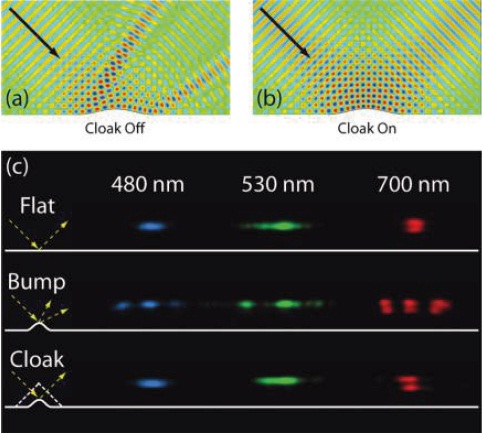摘要:据美国物理学家组织网6月16日(北京时间)报道,由于材料技术的限制,目前大多数隐身斗篷只对红外线等非可见光有效,即便能在可见光下实现隐形的也需要借助一定的条件。日前,美国加州大学伯克利分校的研究人员突破了这一难点,让隐身斗篷下的一个300纳米高、6微米宽的物体从全波段可见光中“消失”。相关论文发表在最新一期的《纳米快报》杂志上。
据研究人员介绍,许多先前的研究都使用金属超材料作为制造隐身斗篷的“布料”,但在光学频率中,金属会吸收过多的光线并造成显著损失。今年2月,英国伯明翰大学的研究人员用具有双折射光学性质的方解石晶体来制造隐身斗篷并获得了成功,但该装置只对可见光波段具有某种特定偏振属性的光有效,即该装置只有在特定光线的照射下才能“隐形”。
负责该项研究的加州大学伯克利分校教授张翔说,新的研究中,他们采用了一种被称为拟保角映射(QCM)的技术让一个300纳米高、6微米宽的物体在可见光全波段中实现了“隐形”。由于这种隐身斗篷上有一层覆盖物,研究人员称其为“地毯斗篷”。其中“地毯”在外观上如同一个平滑的镜面,通过一定的技术手段,观察者在可见光中无法察觉其下的覆盖物。
要实现隐身,首先必须改变经过物体四周的光线,使其无法形成反射。为达到这一目的,研究人员设计了一种具有可变折射率的材料,并将其转化为一种自然界中先前并不存在的超材料。这种材料分为两层,衬底是一层透明的纳米多孔二氧化硅,其上是一片氮化硅波导。为达到改变折射率的目的,研究人员还在氮化物上蚀刻出很多小的孔洞以构成所需的图案。通过这种材料,斗篷便可以改变光线的路径,完全遮住下面物体的轮廓,从而达到隐身的目的。
张翔称,该装置是首个可在可见光波段中奏效的隐身斗篷,新技术使可见光领域内的光学转换技术又前进了一步。除伪装外,研究人员将能更自如地操控光线,从而制造出更先进的显微镜和计算机。
编辑圈点
似乎每个人都曾梦想有一件哈利·波特那样的隐身衣,能在危险时隐藏自己,甚至玩点儿捉弄人的恶作剧。科技发展史已无数次证明,梦想常常能照进现实,孕育出新兴的科学。面对“隐身”的巨大诱惑与无限潜能,科学家们的热情投入肯定能找到编织隐身梦的新材料。当然,有矛就得有盾,怎么保证隐身技术不被儿童寓言《隐身草》里财迷心窍的财主之流滥用?恐怕有了隐身衣之后,我们还必须得去研究反隐身手段了。
生物探索推荐英文报道:
Invisibility carpet cloak can hide objects from visible light

Pictured: When an input beam (black arrow) reflects off (a) a bump without a cloak, the bump causes a perturbation. When the beam reflects off (b) a bump covered by a cloak, the cloak masks the bump, and the reflected beam is reconstructed as if the bump did not exist. (c) Light after reflection from a flat mirror, a bump without a cloak, and a cloaked bump, at three different wavelengths.
Most of the invisibility cloaks that have been demonstrated to date conceal objects at frequencies that are not detectable by the human eye. Designing invisibility cloaks that can conceal objects from visible light has been more challenging due to the strict material requirements. But in a new study, researchers have fabricated a carpet cloak that can make objects undetectable in the full visible spectrum.
The researchers, led by Prof. Xiang Zhang at the University of California, Berkeley, and Lawrence Berkeley National Laboratory, have published their study in a recent issue of Nano Letters.
As the researchers explain, most previous invisibility cloaks have used metallic metamaterials for cloaking at microwave frequencies. But at optical frequencies, the metal absorbs too much light and leads to significant metallic loss, and Berkeley and other groups have had to design dielectric cloaks at infrared frequencies. More recently, researchers at University of Birmingham (UK) have experimented with using uniaxial crystals as the cloak material, which can enable cloaking in visible frequencies, but only for a certain polarization of light.
In the current study, the researchers used a technique called quasi conformal mapping (QCM) to conceal an object with a height of 300 nm and a width of 6 µm underneath a reflective “carpet cloak.” The carpet itself has the appearance of a smooth optical mirror, so that the object and the bump that the object makes underneath the carpet are undetectable by visible light.
“The carpet cloak means that you conceal the object under a layer, which we call carpet, but you see the carpet like a normal mirror, as if it is flat with no bump caused by putting the object underneath,” Zhang told PhysOrg.com. “This way, the observer won't recognize something is concealed underneath.”
In order to guide visible light around the concealed object, the researchers had to make light travel at different speeds while approaching the bump. They achieved this by designing the materials to have a variable refractive index, transforming them into metamaterials, since they don’t appear in nature. The researchers placed a silicon nitride waveguide on a transparent nanoporous silicon oxide substrate that they specially developed to have a much lower refractive index than that of the waveguide. Using nanofabrication techniques, the researchers etched tiny holes into the nitride to make a desired pattern, giving the waveguide the cloaking refractive index profile.
“The concept of the carpet cloak was originally suggested so that you can design a certain pattern for a given size of the bump, and hide an object of arbitrary shape under that,” Zhang said. “If you need to make a bigger size bump to hide a bigger object, a new hole pattern will be required.”
With this refractive index profile, along with the transparency of both the waveguide and the substrate, the cloak could completely conceal an object by producing a light beam profile identical to a beam reflected from a flat carpet with no object underneath.
“This device is among the first cloak devices that operate at visible frequencies; the other very recent visible light cloaks operate based on a principle that relies on a certain polarization of light, whereas the quasi-conformal-based principle does not rely on the polarization,” Zhang said. “Of course, the waveguide geometry entails different operation for different polarizations, which is extrinsic to the QCM design.”
In addition to cloaking, the new technique provides an important step toward implementing optical transformation structures in the visible range. Using transformation optics (TO), researchers can manipulate light for applications such as powerful microscopes and computers.
“The carpet cloak is an example of a wide family of devices that can be made based on transformation optics,” Zhang said. “Besides invisibility, all kinds of optical illusion schemes can be made based on the concept, where the observer receives a different impression when looking at an object. The capability to manipulate light propagation can be used in energy devices, optical computing devices, and beyond, wherever it is desired to have full control on the light path; TO lets us redirect light and re-route it.”
生物探索推荐英文论文摘要:
A Carpet Cloak for Visible Light
Abstract
We report an invisibility carpet cloak device, which is capable of making an object undetectable by visible light. The cloak is designed using quasi conformal mapping and is fabricated in a silicon nitride waveguide on a specially developed nanoporous silicon oxide substrate with a very low refractive index (n<1.25). The spatial index variation is realized by etching holes of various sizes in the nitride layer at deep subwavelength scale creating a local effective medium index. The fabricated device demonstrates wideband invisibility throughout the visible spectrum with low loss. This silicon nitride on low index substrate can also be a general scheme for implementation of transformation optical devices at visible frequencies.
Keywords: Optical metamaterials; invisibility cloak; transformation optics; nanofabrication







